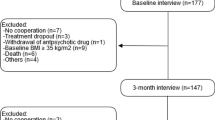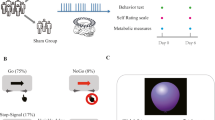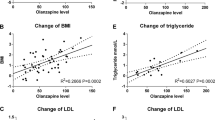Abstract
Antipsychotic-induced weight gain has emerged as a serious complication in the treatment of patients with atypical antipsychotic drugs. The cannabinoid receptor 1 (CNR1) is expressed centrally in the hypothalamic region and associated with appetite and satiety, as well as peripherally. An antagonist of CNR1 (rimonabant) has been effective in causing weight loss in obese patients indicating that CNR1 might be important in antipsychotic-induced weight gain. Twenty tag SNPs were analyzed in 183 patients who underwent treatment (with either clozapine, olanzapine, haloperidol, or risperidone) for chronic schizophrenia were evaluated for antipsychotic-induced weight gain for up to 14 weeks. The polymorphism rs806378 was nominally associated with weight gain in patients of European ancestry treated with clozapine or olanzapine. ‘T’ allele carriers (CT+TT) gained more weight (5.96%), than the CC carriers (2.76%, p=0.008, FDR q-value=0.12). This translated into approximately 2.2 kg more weight gain in patients carrying the T allele than the patients homozygous for the CC genotype (CC vs CT+TT, 2.21±4.51 vs 4.33±3.89 kg; p=0.022). This was reflected in the allelic analysis (C vs T allele, 3.84 vs 5.83%, p=0.035). We conducted electrophoretic mobility shift assays which showed that the presence of the T allele created a binding site for arylhydrocarbon receptor translocator (ARNT), a member of the basic helix–loop–helix/Per–Arnt–Sim protein family. In this study, we provide evidence that the CNR1 gene may be associated with antipsychotic-induced weight gain in chronic schizophrenia patients. However, these observations were made in a relatively small patient population; therefore these results need to be replicated in larger sample sets.
Similar content being viewed by others
Log in or create a free account to read this content
Gain free access to this article, as well as selected content from this journal and more on nature.com
or
References
Aberle J, Fedderwitz I, Klages N, George E, Beil FU (2007). Genetic variation in two proteins of the endocannabinoid system and their influence on body mass index and metabolism under low fat diet. Horm Metab Res 39: 395–397.
Ameri A, Wilhelm A, Simmet T (1999). Effects of the endogeneous cannabinoid, anandamide, on neuronal activity in rat hippocampal slices. Br J Pharmacol 126: 1831–1839.
Barrett JC, Fry B, Maller J, Daly MJ (2005). Haploview: analysis and visualization of LD and haplotype maps. Bioinformatics 21: 263–265.
Basile VS, Masellis M, De Luca V, Meltzer HY, Kennedy JL (2002). 759C/T genetic variation of 5HT(2C) receptor and clozapine-induced weight gain. Lancet 360: 1790–1791.
Baye TM, Zhang Y, Smith E, Hillard CJ, Gunnell J, Myklebust J et al (2008). Genetic variation in cannabinoid receptor 1 (CNR1) is associated with derangements in lipid homeostasis, independent of body mass index. Pharmacogenomics 9: 1647–1656.
Beal JE, Olson R, Laubenstein L, Morales JO, Bellman P, Yangco B et al (1995). Dronabinol as a treatment for anorexia associated with weight loss in patients with AIDS. J Pain Symptom Manage 10: 89–97.
Benzinou M, Chevre JC, Ward KJ, Lecoeur C, Dina C, Lobbens S et al (2008). Endocannabinoid receptor 1 gene variations increase risk for obesity and modulate body mass index in European populations. Hum Mol Genet 17: 1916–1921.
Clauss IM, Chu M, Zhao JL, Glimcher LH (1996). The basic domain/leucine zipper protein hXBP-1 preferentially binds to and transactivates CRE-like sequences containing an ACGT core. Nucleic Acids Res 24: 1855–1864.
Cota D, Marsicano G, Tschop M, Grubler Y, Flachskamm C, Schubert M et al (2003). The endogenous cannabinoid system affects energy balance via central orexigenic drive and peripheral lipogenesis. J Clin Invest 112: 423–431.
De Luca V, Mueller DJ, de Bartolomeis A, Kennedy JL (2007). Association of the HTR2C gene and antipsychotic induced weight gain: a meta-analysis. Int J Neuropsychopharmacol 10: 697–704.
Di Marzo V, Goparaju SK, Wang L, Liu J, Batkai S, Jarai Z et al (2001). Leptin-regulated endocannabinoids are involved in maintaining food intake. Nature 410: 822–825.
Dudbridge F (2003). Pedigree disequilibrium tests for multilocus haplotypes. Genet Epidemiol 25: 115–121.
Ellingrod VL, Bishop JR, Moline J, Lin YC, Miller del D (2007). Leptin and leptin receptor gene polymorphisms and increases in body mass index (BMI) from olanzapine treatment in persons with schizophrenia. Psychopharmacol Bull 40: 57–62.
Faivre L, Cormier-Daire V, Lapierre JM, Colleaux L, Jacquemont S, Genevieve D et al (2002). Deletion of the SIM1 gene (6q16.2) in a patient with a Prader-Willi-like phenotype. J Med Genet 39: 594–596.
Gamber KM, Macarthur H, Westfall TC (2005). Cannabinoids augment the release of neuropeptide Y in the rat hypothalamus. Neuropharmacology 49: 646–652.
Gauderman WJ, Morrison JM (2006). QUANTO 1.1: A computer program for power and sample size calculations for genetic-epidemiology studies. http://hydra.usc.edu/gxe.
Gazzerro P, Caruso MG, Notarnicola M, Misciagna G, Guerra V, Laezza C et al (2007). Association between cannabinoid type-1 receptor polymorphism and body mass index in a southern Italian population. Int J Obes (London) 31: 908–912.
Holder Jr JL, Butte NF, Zinn AR (2000). Profound obesity associated with a balanced translocation that disrupts the SIM1 gene. Hum Mol Genet 9: 101–108.
Hutchison KE, Haughey H, Niculescu M, Schacht J, Kaiser A, Stitzel J et al (2008). The incentive salience of alcohol: translating the effects of genetic variant in CNR1. Arch Gen Psychiatry 65: 841–850.
Jaeger JP, Mattevi VS, Callegari-Jacques SM, Hutz MH (2008). Cannabinoid type-1 receptor gene polymorphisms are associated with central obesity in a Southern Brazilian population. Dis Markers 25: 67–74.
Jamshidi N, Taylor DA (2001). Anandamide administration into the ventromedial hypothalamus stimulates appetite in rats. Br J Pharmacol 134: 1151–1154.
Käll L, Storey JD, Noble WS (2009). QVALITY: non-parametric estimation of q-values and posterior error probabilities. Bioinformatics 25: 964–966.
Kirkham TC, Williams CM, Fezza F, Di Marzo V (2002). Endocannabinoid levels in rat limbic forebrain and hypothalamus in relation to fasting, feeding and satiation: stimulation of eating by 2-arachidonoyl glycerol. Br J Pharmacol 136: 550–557.
Kola B, Farkas I, Christ-Crain M, Wittmann G, Lolli F, Amin F et al (2008). The orexigenic effect of ghrelin is mediated through central activation of the endogenous cannabinoid system. PLoS One 3: e1797.
Kunos G (2007). Understanding metabolic homeostasis and imbalance: what is the role of the endocannabinoid system? Am J Med 120: S18–S24; discussion S24.
Lahiri DK, Nurnberger Jr JI (1991). A rapid non-enzymatic method for the preparation of HMW DNA from blood for RFLP studies. Nucleic Acids Res 19: 5444.
Le Hellard S, Theisen FM, Haberhausen M, Raeder MB, Ferno J, Gebhardt S et al (2009). Association between the insulin-induced gene 2 (INSIG2) and weight gain in a German sample of antipsychotic-treated schizophrenic patients: perturbation of SREBP-controlled lipogenesis in drug-related metabolic adverse effects? Mol Psychiatry 14: 308–317.
Lieb W, Manning AK, Florez JC, Dupuis J, Cupples LA, McAteer JB et al (2009). Variants in the CNR1 and the FAAH genes and adiposity traits in the community. Obesity (Silver Spring) 17: 755–760.
Makkonen H, Kauhanen M, Paakinaho V, Jaaskelainen T, Palvimo JJ (2009). Long-range activation of FKBP51 transcription by the androgen receptor via distal intronic enhancers. Nucleic Acids Res 37: 4135–4148.
Masellis M, Basile V, Meltzer HY, Lieberman JA, Sevy S, Macciardi FM et al (1998). Serotonin subtype 2 receptor genes and clinical response to clozapine in schizophrenia patients. Neuropsychopharmacology 19: 123–132.
Matias I, Di Marzo V (2007). Endocannabinoids and the control of energy balance. Trends Endocrinol Metab 18: 27–37.
Michaud JL, Boucher F, Melnyk A, Gauthier F, Goshu E, Levy E et al (2001). Sim1 haploinsufficiency causes hyperphagia, obesity and reduction of the paraventricular nucleus of the hypothalamus. Hum Mol Genet 10: 1465–1473.
Monteleone P, Bifulco M, Di Filippo C, Gazzerro P, Canestrelli B, Monteleone F et al (2009). Association of CNR1 and FAAH endocannabinoid gene polymorphisms with anorexia nervosa and bulimia nervosa: evidence for synergistic effects. Genes Brain Behav 8: 728–732.
Muller DJ, De Luca V, Sicard T, King N, Hwang R, Volavka J et al (2005a). Suggestive association between the C825T polymorphism of the G-protein beta3 subunit gene (GNB3) and clinical improvement with antipsychotics in schizophrenia. Eur Neuropsychopharmacol 15: 525–531.
Muller DJ, Kennedy JL (2006). Genetics of antipsychotic treatment emergent weight gain in schizophrenia. Pharmacogenomics 7: 863–887.
Muller DJ, Klempan TA, De Luca V, Sicard T, Volavka J, Czobor P et al (2005b). The SNAP-25 gene may be associated with clinical response and weight gain in antipsychotic treatment of schizophrenia. Neurosci Lett 379: 81–89.
Muller TD, Reichwald K, Bronner G, Kirschner J, Nguyen TT, Scherag A et al (2008). Lack of association of genetic variants in genes of the endocannabinoid system with anorexia nervosa. Child Adolesc Psychiatry Ment Health 2: 33.
Muller TD, Reichwald K, Wermter AK, Bronner G, Nguyen TT, Friedel S et al (2007). No evidence for an involvement of variants in the cannabinoid receptor gene (CNR1) in obesity in German children and adolescents. Mol Genet Metab 90: 429–434.
Nasrallah HA (2008). Atypical antipsychotic-induced metabolic side effects: insights from receptor-binding profiles. Mol Psychiatry 13: 27–35.
Nelson K, Walsh D, Deeter P, Sheehan F (1994). A phase II study of delta-9-tetrahydrocannabinol for appetite stimulation in cancer-associated anorexia. J Palliat Care 10: 14–18.
Osei-Hyiaman D, DePetrillo M, Pacher P, Liu J, Radaeva S, Batkai S et al (2005). Endocannabinoid activation at hepatic CB1 receptors stimulates fatty acid synthesis and contributes to diet-induced obesity. J Clin Invest 115: 1298–1305.
Ott CJ, Suszko M, Blackledge NP, Wright JE, Crawford GE, Harris A (2009). A complex intronic enhancer regulates expression of the CFTR gene by direct interaction with the promoter. J Cell Mol Med 13: 680–692.
Peeters A, Beckers S, Mertens I, Van Hul W, Van Gaal L (2007). The G1422A variant of the cannabinoid receptor gene (CNR1) is associated with abdominal adiposity in obese men. Endocrine 31: 138–141.
Ravinet Trillou C, Arnone M, Delgorge C, Gonalons N, Keane P, Maffrand JP et al (2003). Anti-obesity effect of SR141716, a CB1 receptor antagonist, in diet-induced obese mice. Am J Physiol Regul Integr Comp Physiol 284: R345–R353.
Ravinet Trillou C, Delgorge C, Menet C, Arnone M, Soubrie P (2004). CB1 cannabinoid receptor knockout in mice leads to leanness, resistance to diet-induced obesity and enhanced leptin sensitivity. Int J Obes Relat Metab Disord 28: 640–648.
Russo P, Strazzullo P, Cappuccio FP, Tregouet DA, Lauria F, Loguercio M et al (2007). Genetic variations at the endocannabinoid type 1 receptor gene (CNR1) are associated with obesity phenotypes in men. J Clin Endocrinol Metab 92: 2382–2386.
Sarzani R, Bordicchia M, Marcucci P, Bedetta S, Santini S, Giovagnoli A et al (2009). Altered pattern of cannabinoid type 1 receptor expression in adipose tissue of dysmetabolic and overweight patients. Metabolism 58: 361–367.
Siegfried Z, Kanyas K, Latzer Y, Karni O, Bloch M, Lerer B et al (2004). Association study of cannabinoid receptor gene (CNR1) alleles and anorexia nervosa: differences between restricting and binging/purging subtypes. Am J Med Genet B Neuropsychiatr Genet 125B: 126–130.
Templeman LA, Reynolds GP, Arranz B, San L (2005). Polymorphisms of the 5-HT2C receptor and leptin genes are associated with antipsychotic drug-induced weight gain in Caucasian subjects with a first-episode psychosis. Pharmacogenet Genomics 15: 195–200.
van den Berg SW, Dollé ME, Imholz S, van der A DL, van ‘t Slot R, Wijmenga C et al (2009). Genetic variations in regulatory pathways of fatty acid and glucose metabolism are associated with obesity phenotypes: a population-based cohort study. Int J Obes (London) 33: 1143–1152.
Volavka J, Czobor P, Sheitman B, Lindenmayer JP, Citrome L, McEvoy JP et al (2002). Clozapine, olanzapine, risperidone, and haloperidol in the treatment of patients with chronic schizophrenia and schizoaffective disorder. Am J Psychiatry 159: 255–262.
Weston-Green K, Huang XF, Han M, Deng C (2008). The effects of antipsychotics on the density of cannabinoid receptors in the dorsal vagal complex of rats: implications for olanzapine-induced weight gain. Int J Neuropsychopharmacol 11: 827–835.
Woods SC (2007). Role of the endocannabinoid system in regulating cardiovascular and metabolic risk factors. Am J Med 120: S19–S25.
Yang C, Boucher F, Tremblay A, Michaud JL (2004). Regulatory interaction between arylhydrocarbon receptor and SIM1, two basic helix-loop-helix PAS proteins involved in the control of food intake. J Biol Chem 279: 9306–9312.
Zhang PW, Ishiguro H, Ohtsuki T, Hess J, Carillo F, Walther D et al (2004). Human cannabinoid receptor 1: 5′ exons, candidate regulatory regions, polymorphisms, haplotypes and association with polysubstance abuse. Mol Psychiatry 9: 916–931.
Zhang ZJ, Yao ZJ, Mou XD, Chen JF, Zhu RX, Liu W et al (2003). [Association of −2548G/A functional polymorphism in the promoter region of leptin gene with antipsychotic agent-induced weight gain]. Zhonghua Yi Xue Za Zhi 83: 2119–2123.
Acknowledgements
Canadian Institute of Health Research (CIHR) postdoctoral fellowship to AKT and RPS; CIHR operating grants to JLK and DJM (Genetics of Antipsychotic induced Metabolic Syndrome); NARSAD grants to DJM, MH41468, the Prentiss Foundation, Ritter Foundation, Hintz family, and the Peterson Family to HYM; The Bebensee Foundation fellowship to CCZ.
Author information
Authors and Affiliations
Corresponding author
Ethics declarations
Competing interests
AKT/CCZ/OL/DS/RPS/PB/SZDJM/AL/IP: report no competing interests. HYM has received grants or is a consultant to: Abbott Labs, ACADIA, Bristol Myers Squibb, Eli Lilly, Jansse, Pfizer, Astra Zeneca, Glaxo Smith Kline, Memory, Cephalon, Minster, Aryx, and BiolineRx. HYM is a shareholder of ACADIA. JAL reports having received research funding or consulting or educational fees from Allon, AstraZeneca, Bioline, Bristol-Myers Squibb, Eli Lilly, Forest Labs, GlaxoSmithKline, Janssen, Merck, Novartis, Pfizer, Solvay and Wyeth. JLK has been a consultant to GSK, Sanofi-Aventis, Dainippon-Sumitomo.
Additional information
Supplementary Information accompanies the paper on the Neuropsychopharmacology website
Supplementary information
Rights and permissions
About this article
Cite this article
Tiwari, A., Zai, C., Likhodi, O. et al. A Common Polymorphism in the Cannabinoid Receptor 1 (CNR1) Gene is Associated with Antipsychotic-Induced Weight Gain in Schizophrenia. Neuropsychopharmacol 35, 1315–1324 (2010). https://doi.org/10.1038/npp.2009.235
Received:
Revised:
Accepted:
Published:
Issue date:
DOI: https://doi.org/10.1038/npp.2009.235
Keywords
This article is cited by
-
Polygenic risk scores analyses of psychiatric and metabolic traits with antipsychotic-induced weight gain in schizophrenia: an exploratory study
The Pharmacogenomics Journal (2023)
-
Clinical utility of combinatorial pharmacogenomic testing in depression: A Canadian patient- and rater-blinded, randomized, controlled trial
Translational Psychiatry (2022)
-
The association between BDNF levels and risperidone-induced weight gain is dependent on the BDNF Val66Met polymorphism in antipsychotic-naive first episode schizophrenia patients: a 12-week prospective study
Translational Psychiatry (2021)
-
Association of CNR1 and INSIG2 polymorphisms with antipsychotics-induced weight gain: a prospective nested case–control study
Scientific Reports (2021)
-
Testing the role of genetic variation of the MC4R gene in Chinese population in antipsychotic-induced metabolic disturbance
Science China Life Sciences (2019)



